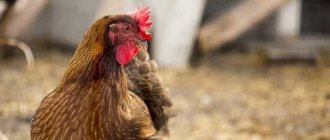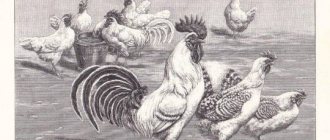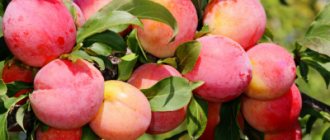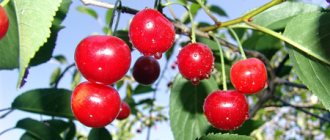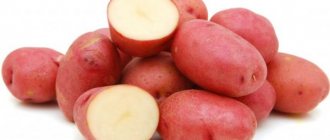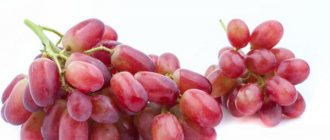History of appearance
The Kuban Red was bred in the Krasnodar region in 1995. The place of breeding was the Labinsk breeding plant. The breeders' goal was to create breeds with high egg production. They crossed two breeds of chickens - Rhode Island and Leghorn. In fact, “UK Kuban-7” is more of a cross (hybrid) than a full-fledged breed. Selection work to improve the characteristics of the hybrid is ongoing.
The breeders are tasked with increasing the egg production of the breed. When selecting birds for breeding, the developers relied on the following qualities of the breed:
- dense shell;
- beautiful shell color;
- high commercial quality of eggs;
- large yolk;
- nutritional value of eggs;
- quality protein;
- high quality meat and presentation of carcasses;
- stress resistance.
As a result, they managed to obtain birds with unprecedentedly high profitability.
Description of the breed
Although the Kuban Red is considered an egg breed, it produces high-quality meat and is attractive in appearance. For many private owners, the external beauty of chickens is an important factor when choosing a breed.
A distinctive feature of the UK Kuban-7 chickens is their high egg production, which does not stop even with the onset of cold weather. This is important for breeders who do not have heated chicken coops.
The Kuban Red is a very young breed, but has already become popular. The reasons for its popularity are obvious:
- high egg production;
- minimal feed costs.
Thanks to the combination of the above factors, Kubanka is very profitable for creating a “chicken” business.
Other distinctive features of "UK Kuban-7":
- Already a month after hatching, males and females can be distinguished from each other.
- In order for most of the eggs to be fertilized, it is enough to have one rooster for every ten hens.
- To prevent the egg production of Kuban chickens from falling, they are not raised for eggs - the management of their offspring is entrusted to hens of less productive breeds.
- Vitality, non-conflict and moderate curiosity. Birds of this breed behave calmly and phlegmatically. They change their habitat without any problems - they move from the chicken coop to the street and vice versa.
Exterior
Kuban red chicken is no different from egg breeds. Appearance characteristics are in Table 1.
Table 1
| External sign/characteristic | Description |
| Body | compact, without excess weight |
| Neck | short, high-set |
| Head | small |
| Breast | wide, with developed muscles, smoothly transitions to the stomach |
| Crest | bright red color, leaf-shaped shape, earrings and earlobes – red |
| Paws | powerful and short |
| Wings | tight to the body |
| Plumage | red-brown in color (sometimes there are black and white feathers in the plumage), the ends of the tail and wings have a grayish tint |
| Weight | chicken – 2 kg, roosters – 3 kg |
Chicken is a small bird. Among the fiery red plumage there are gray specks on the tail and wings. The leader of the pack is also not very large. And in appearance it is not particularly different from chickens. Perhaps the size is a little larger, and the appearance is more masculine. The rooster differs from the hen in having more powerful legs, a wide chest and a long crest.
Appearance of the female
The appearance of the hen is very different from her predecessors. The description is as follows: the feathered chicken is small in size. Her body weight does not grow more than two kilograms. A special distinguishing feature is the bright red or brown feathers. They cover the chicken's slender body very tightly.
Some laying hens have their own unique feature - gray dots in the area of the wings and at the end of the tail. This beauty is framed by a bright, even small comb. The egg type of productivity determines the individual's skeletal structure. He will be light and slender.
Productivity
Kuban red chickens are bred for eggs. Therefore, the main characteristic of their productivity is egg production. The breed is early maturing - already 4 months after birth, “Kubankas” can lay eggs. Meat breeds acquire this ability only by 6 or even 8 months.
Eggs
One chicken can produce up to 340 eggs per year. But such productivity is observed only with high-quality care. With average care, egg production is reduced to 250 eggs per year. To achieve maximum profitability, it is necessary to provide laying hens with a properly selected diet and good housing conditions. One egg weighs 55-60 g.
Meat
The meat of this cross is dietary. It is distinguished by its tenderness, juiciness, and is not at all greasy. Females weigh 2 kg, males 3 kg. Meat yield at slaughter is 55-60%. From one chicken you can get a carcass weighing 1-1.5 kg.
Maturation and motherhood
The female of the Kuban red breed is distinguished by an unprecedentedly early maturation. Already at 4 months she is able to reproduce - lay eggs, which is what breeders require from her. The shell acquires the necessary qualities only 2 weeks after the start of oviposition. The color of the shell is golden or light brown. The farmer’s task is to help the young laying hen lay eggs by replenishing her body with calcium.
If you do not give the chicken special calcium supplements in time, she will peck the laid eggs. In the future, this quality may become a habit.
Eggs reach their maximum size when the hen is six months old.
Females have a developed maternal instinct and hatch eggs well. The main thing is to provide them with everything necessary for life during hatching. If desired, eggs can be placed on hens of other breeds - so as not to distract productive hens from laying eggs.
To start breeding crosses, and not bother with chickens, you need to take 4-month-old birds.
Rules for purchasing young animals
It is very important to learn how to choose the right chickens to buy. You can purchase young animals at poultry farms, specialized hatcheries, as well as from private traders.
- They say that poultry farms may sell rejected animals, and therefore prices there are usually lower. But it is also worth noting that such enterprises always carry out veterinary control, which will save the buyer from the risk of purchasing a sick bird.
- As for private sellers, they usually offer small quantities of birds, most often at markets. It can be difficult to determine the breed here and sometimes you can run into scammers. But if the seller is trusted and honest, then the hen hens will probably be healthy and as strong as possible.
- Specialized hatcheries usually offer wholesale quantities of chicks for sale. The order must be made in advance. Perhaps this method of purchasing will not be convenient for everyone, but with this option you can be confident in the quality characteristics of the young animals, since such an enterprise will always work for its reputation.
The age of young animals offered for sale usually ranges from 1 to 10 days. Accordingly, the older the chickens, the more expensive they are. But at the same time, the older the chicken, the greater the likelihood that it will survive and develop well. A good percentage of survival of young animals is considered to be the death of 2-4 individuals (no more) out of 50 pieces. But it is still recommended to carefully select healthy and strong birds in order to improve these statistics.
Read also: How to properly feed broiler chickens: description of the diet
The chicken should be clean, its fluff should be nice and even. You should also pay attention to the area around the cloaca; it should be clean and free of inflammation. A healthy and hardy individual is a chicken that stands confidently on its feet and moves boldly. The eyes should be fully open and slightly shiny. The wings should be pressed tightly to the body, and not sag down. There should be no bleeding on the umbilical cord. The tummy should be soft and not bloated. Young animals should be carefully examined for abnormalities and external defects.
Healthy individuals are always active and mobile. Their voice is clear, without wheezing. Checking the activity of pets is very simple - you need to lightly knock on the box where they are located and evaluate their behavioral changes. Also, young animals must respond to food and eat with appetite.
Important! Before choosing chickens for purchase, be sure to check their age with the seller. After all, those individuals that hatched less than 7 hours ago will physically not be able to be active and mobile. This stage will come for them later.
Content Features
The Kuban Red breed has a fairly strong immune system. True, if the bird is kept in good conditions and receives adequate nutrition.
Care
Like any cross created for keeping in cages, “UK Kuban-7” most of all does not like dampness. The bird must be provided with the following conditions:
- The chicken coop must be dry.
- The room must have forced ventilation. As a last resort, open the window, regularly ventilating the chicken coop.
- There should be no drafts in the room where chickens are kept.
- The room must be clean. To do this, drinkers and feeders are placed above the floor surface so that birds do not contaminate the bedding with water and feed. The height should be such that each bird can easily eat and drink, but cannot climb into the trays with its paws.
- For egg-laying, “nests” are organized - wooden boxes placed on the floor, lined with straw, which is changed regularly so that the eggs are clean. Nests can also be placed on walls - at a distance of 80 cm from the floor surface, or on stands equipped with ladders - so that it is convenient for the chicken to climb into them.
- To prevent egg production from decreasing during the cold season, daylight hours are extended for laying hens to 12 hours with the help of artificial lighting.
- The temperature in the room where the poultry is kept should not fall below -2°C. The breed is thermophilic; in cold weather, birds can freeze their combs. In addition, in need of energy to keep warm, chickens begin to intensively absorb food. To prevent egg production from falling, the temperature in the chicken coop should not fall below +10°C.
- The breed does not like heat. If the temperature is above +27°C, the birds refuse to eat, and the eggs have a bad shell - too thin. It happens that during the hot season, females lay eggs without shells at all.
- The optimal temperature regime is +17…+19°С. Such conditions can be created for laying hens only in special poultry farms equipped with climate control systems.
- The chicken coop must be completely cleaned twice a year. The walls are painted with lime. The frequency of painting depends on the livestock. If there are less than 100 birds in the flock, they paint once a year, more than 100 birds - 4 times a year.
- If there is no heating in the chicken coop, you need to lay a thick bedding on the floor - made of straw or sawdust. The thickness of the litter is from 20 cm.
If your farm does not have a place for breeding birds, then we recommend reading the article on how to make a chicken coop with your own hands.
Feeding
The cross "UK Kuban-7" is productive if it receives the right diet. 50% of the chicken menu should be grains. The breed is demanding regarding protein foods, so the diet includes food with plant and animal proteins.
The bird is fed:
- peas;
- soy;
- alfalfa;
- cottage cheese;
- whey;
- meat and bone meal;
- meat broth.
To ensure that chickens receive the required amount of calcium, they are fed feed chalk, crushed eggshells, and shells.
Birds can be fed finely chopped fish - they willingly eat it, but it should be taken into account that their meat will have a specific smell.
In spring, the feed is enriched with vitamin and mineral premixes. In the summer, fresh grass and garden herbs are introduced into the chickens’ diet. They prepare hay for the winter - clover and alfalfa. The hay should have leaves. In dry hay, chickens can only peck dried leaves and petals. Hard straw is not suitable - there is nothing for chickens to eat in it. When the birds have eaten everything tasty - leaves and flower petals, the hay can be placed on the bedding.
The bird is fed wet mash prepared from cottage cheese, whey or broth. This food is given little by little so that it does not stagnate in the feeders. In the heat, such mashes will quickly turn sour, and chickens that eat stale food will develop digestive problems. The mash should not lie in the feeder for more than half an hour.
Laying hens need to be fed twice a day. The grain is supplemented with:
- legumes;
- mixed feed;
- bran;
- vegetables;
- grass.
Drinkers should always contain water - it is changed once a day in winter, and 2 times a day in summer. It is recommended to add nettle decoction to the water in winter to replenish the bird’s body with vitamins.
An approximate daily ration for laying hens (per head) is in Table 2.
table 2
| Feed | Daily value, g | |
| summer | winter | |
| Cereals (grain) | 45 | 55 |
| Grains and legumes | 5 | 5 |
| Mealy feed | 20 | 20 |
| Cake, meal, yeast | 7 | 6 |
| Animal feed | 5 | 5 |
| Greens, roots, tubers | 55 | 20 |
| Hay flour, pine flour, grass flour | — | 5 |
Laying hens must receive grain - oats, wheat, corn and barley. They give the grain one at a time - without mixing everything together.
Benefits of grains for chickens:
- Wheat is rich in vitamin A and E. It is a source of protein. Can account for 60% of the total mass of feed.
- Barley – improves the quality characteristics of meat.
- Oats are a source of fiber.
- Corn – needed to increase egg production.
In warm weather, when there is access to grass feed, the chickens' diet should contain about 40% grass. This is both beneficial for farmers and good for chickens. In summer you can also give chickens additionally:
- nettle;
- zucchini;
- pumpkin;
- cucumbers;
- beet tops, radishes, etc.
Maybe
How to increase egg production of red chickens
Chickens of egg-laying breeds most often begin to lay eggs at the age of 4 months. Maximum egg production occurs at the age of 10–11 months. Most often, when breeding poultry at home, this age falls in autumn or even winter. The chicken begins to demand more attention.
Chickens of egg-laying breeds most often begin to lay eggs at the age of 4 months.
If a farmer wants to maintain productivity or even increase it, the following is necessary:
- Increase daylight hours using artificial lighting to 15 hours a day.
- Maintain a comfortable temperature in the chicken coop (16 - 23 degrees). Any deviation reduces egg production by 10% or more.
- Change your diet. Using premixes and concentrated feeds allows chickens to eat less food and feel fuller for much longer. The vitamins and minerals in the product help strengthen the birds’ immunity and replenish the missing elements in the body.
- Pay attention to the arrangement of nests. Perhaps they are uncomfortable and the chickens lay eggs in secret places during walks.
- Eliminate sources of noise and harsh sounds around the chicken coop.
- Pay attention to the behavior of birds. Perhaps they were stressed and the decrease in egg production will be a temporary phenomenon.
The egg production of chickens largely depends on the conditions of detention, and not on the breed
The egg production of chickens depends on the breed by only 20%. The rest is the painstaking work of the farmer. If he follows the standards for keeping and feeding poultry, its productivity can reach more than 90%.
Prices for Premix for chickens
Premix for chickens
Video - Increasing egg production of chickens
Care and maintenance in winter
In winter, the diet of laying hens is adjusted:
- The number of feedings increases from 2 to 3 times a day. Mixed food and succulent food are given in the morning and for lunch, and dry food is given in the evening. Rough food takes longer to digest, and the bird will be provided with energy until the morning.
- Green food prepared in the summer is introduced into the diet - hay, dried nettles, branches of coniferous trees.
- Introduce grain porridge, mash, vegetables, and melons into the diet.
- Supplement the diet with sprouted oats, seeds and sunflower cake.
- Feed with fish and bone meal. Add fish oil to roughage.
- The introduction of cottage cheese, whey, and skim milk into the diet has a positive effect on egg production.
- They give calcium - they place a container with sand, pebbles, and shells in the chicken coop.
It is important to remember that excess nutrition has a negative impact on egg production. In winter, overfed laying hens gain weight and, losing activity, lay eggs worse.
Features of keeping chickens in winter:
- One bird – 150 g of feed. If at the next feeding the feeders are empty, then the norms are correct.
- The first feeding is at 6-8 am. Lunch – at 13-00. Dinner - at 5-6 pm.
- In the morning they give mash, before nightfall - cereal grain.
- You can give your chickens table scraps. But it is forbidden to feed laying hens baked goods, brown bread, and meat. Potatoes – only boiled.
A warm chicken coop is organized for winter. The bird can be kept in a special chicken coop, in a polycarbonate greenhouse. How to prepare a place for chickens in a greenhouse:
- remove all debris and excess soil from the premises;
- eliminate the presence of drafts;
- organize ventilation in the room;
- carry out lighting;
- Sprinkle the floor with straw.
Raising chickens
Chicks, having hatched, do not yet know how to properly peck. There are some nutrients in their stomach pouch that help them survive for several hours. When the babies are dry, they need to be immediately offered food - complete food, proven, high-quality and nutritious.
The area where chickens are kept must be kept clean. It is recommended to use feeders that the chickens cannot get into with their paws. Before adding fresh food, carefully remove any uneaten remains.
The condition of the young animals is carefully monitored. Weak and “sad” chickens are removed from the flock and raised separately. Those who refuse to eat are force-fed - by introducing softened food into the beak. You can introduce food with a pipette or syringe without a needle. The nutrition of chickens depends on their age.
Diet for egg-laying chickens in stages:
- Newborns. Small corn grits are suitable for nutrition. Boiled eggs are now not recommended - veterinarians say that eggs burden the stomachs of chickens.
- Daily allowance. The following foods can be included in the diet:
- barley, corn and wheat cereals;
semolina;
- millet;
- ground oatmeal.
- Up to one week. One grain is not enough for the full development of chickens. It is recommended to gradually introduce cottage cheese into the diet - a source of calcium and nitrogen. It is first added to the usual food, and if there is no digestive upset, it is given without additives. From three days you can give kefir, yogurt, whey, as well as fresh herbs:
- nettle;
clover;
- dandelion;
- plantain.
- More than a week. The diet is mixed - cereals, greens, fermented milk products, complexes of vitamins and minerals. When the chickens have matured, the frequency of feedings is reduced to 4-5 times a day. After lactic acid products, thoroughly wash the dishes by scalding them with boiling water.
- Month. Month-old chicks should be able to walk - they can already look for food on their own. Coarse grains are gradually introduced into the diet. They give a wet mash with the addition of bone meal and food waste. After another 2 weeks, you can feed whole grains. You should not give crushed shells - it is quite possible that chickens will eat the eggs because of this. It is better to feed x ground shells.
- After three months. You can give industrial feed.
Day old chicks are fed at intervals of 2 hours. Cereals should not be mixed - it is better to give them separately.
There should always be fresh water in drinking bowls. It needs to be replaced promptly, as chickens like to get into the water with their paws. If they start to have diarrhea, replace the water with a weak solution of potassium permanganate.
The leaves are given dried, after being cut into small pieces. On the fifth day, you can give green onions to prevent infections. Also gradually begin to introduce grated vegetables - beets, pumpkin, carrots. At this age, they give vitamin complexes with yeast.
It is strictly forbidden to give milk to chickens - it causes diarrhea and sticking of the plumage.
Feeding and diet
The productivity and health of the bird directly depends on proper and balanced feeding.
Chicken diet ingredients:
- Crushed grain: barley, wheat, rye;
- Eggshells, legumes, lupine, meat and bone meal
- Wet warm mash with milk in winter
- Shell rock, chalk, grass
- Leftover fresh vegetables and fruits: watermelon rinds, whole zucchini, pumpkins,
- Vitamin complex
Their diet must include the following products: green grass; complex of vitamins; chalk and crushed shell rock; cereals and grains; Skim milk and whey should be added to the mash
Feeding babies is traditional. During the first days, the baby eats traditional eggs, ground with fine corn grits or semolina.
It is very important to supplement the diet with vitamin supplements to ensure full development of the babies.
Why do chickens lose feathers?
Chicken feathers can fall out for various reasons:
- Shedding. This is a seasonal phenomenon. A chicken loses its feathers in a specific sequence. First, feathers fall out in the neck area, then on the back, then on the belly and on the wings. Young chickens molt in the spring, adult chickens in the fall. Molting lasts 1-2 months.
- Rooster aggression. The rooster, when fertilizing the hen, holds on to her back and sides with his claws. If you violate the proportion of 10:1 (one rooster for every 10 hens), then there may be problems. If there are few roosters, the likelihood of fertilization of eggs decreases. If, on the contrary, there are few hens, the rooster works excessively - he tramples every hen several times a day, because of this the females lose their feathers.
- Stress. Changing coops can be stressful. Due to the move, chickens may refuse to eat, they move little and even lose feathers. Adaptation usually takes half a month.
- Diseases. Feathers can fall out due to vitamin deficiency, which occurs due to poor nutrition. Lack of vitamins is the reason why chickens stop laying eggs, they look bad - they go bald, losing not only feathers, but also down.
- Parasites. A bird can go bald due to parasites - fleas and ticks. To combat parasites, special medications or ash are used.
What diseases do chickens have?
Kuban chickens, although they have excellent immunity, are still not immune from diseases. Most diseases are associated with parasites that overwhelm chickens, so you need to create all the conditions to prevent their occurrence. Symptoms that indicate the presence of the disease should alert breeders:
- the bird is lethargic;
- no interest in food;
- does not move, sits with eyes closed;
- loss of plumage is the first symptom of the presence of skin parasites.
These signs are enough to suspect something is wrong and take a closer look at the bird. She may have the following symptoms:
- foam in beak;
- there is mucus in the nose;
- diarrhea;
- sloppy, disheveled appearance;
- severe loss of plumage.
What diseases can Kuban red chickens suffer from:
- Infectious. These are the most dangerous diseases that rarely end in recovery. Among the dangerous diseases are, for example: Pasteurellosis. There is a high temperature, foam comes from the beak and nose, breathing is hoarse, the comb turns blue, and there are bloody clots in the droppings.
- Chicken pox. The head and other parts of the bird's body are covered with red spots. As they become rougher, they turn yellowish-brown. The chicken becomes aggressive, refuses to feed, and may lose its vision.
- aptteriosis and hepatosis - due to irregular feeding;
Prevention
In order for laying hens to lay eggs properly and not get sick, in addition to proper maintenance and feeding, preventive vaccination is needed. Young birds can be vaccinated against the following diseases:
- infectious bronchitis;
- salmonella;
- bursitis;
- mycoplasmosis and others.
The calendar of preventive vaccinations is in Table 3.
Table 3
| Age for vaccination | Disease |
| Hatching day | Marek's disease |
| Second day of life | salmonella |
| 6-7 days | coccidiosis |
| End of the third week | infectious bursitis |
A measure of disease prevention is also taking care of cleanliness. You need to clean the chicken coop thoroughly. This is especially important in winter - when birds are indoors around the clock. It is necessary to periodically wash the feeders and drinkers, change the straw on the floor, and keep the poles clean.
Common diseases and their prevention
Possible ailments
High immunity allows Kuban red chickens to effectively fight popular chicken diseases. But even these birds sometimes get sick.
Among the common diseases in chickens of this breed are leg diseases, skin and feather parasites, eating disorders, and internal parasites.
Illnesses arise due to improper maintenance and feeding. Excessive humidity is an excellent environment for the proliferation of bacteria and fungi. Untimely disinfection of drinkers and feeders, poor-quality or missing feed can provoke the appearance of parasites inside the body of chickens. The absence of ash and sand attracts lice and mites.
Symptoms and preventive measures
If the following signs are noticed in Kuban red chickens, it is recommended to contact a veterinarian:
- lethargy and unsteady gait;
- the chicken sits in an unnatural position;
- cough;
- dirty plumage near the cloaca;
- foam at the beak;
- white feces;
- lack of appetite.
To avoid pathologies, you need to carry out preventive measures in a timely manner: regularly examine all Kuban red chickens, vaccinate them, and also isolate suspicious birds from the general flock to avoid the spread of the disease. We have already written about the benefits of ash baths and disinfection.
Advantages and disadvantages of the breed
Kuban red chickens are a real find for beginning farmers. Having a small weight and consuming little food, she tirelessly lays eggs.
Advantages of the breed:
- Unpretentious in care and maintenance - suitable for beginning farmers.
- High egg production - one individual can lay up to 340 eggs per year.
- Calm character. Not only females are phlegmatic, but also roosters.
- Good adaptation. Usually chickens get used to a new place in about a month; Kuban red laying hens adapt twice as quickly.
- They are undemanding when it comes to diet - they can eat any food. No pre-processing of food is required.
- Laying hens and roosters get along well with each other - without conflicts.
- Early maturity - birds reach sexual maturity at 4 months.
- It is possible to distinguish roosters from females at the age of 1 month.
- Chickens quickly gain weight and have a high (up to 95%) survival rate.
The breed is almost ideal - its advantages can be lost only if feeding and maintenance are violated. Having acquired Kuban red chickens, their owners no longer abandon them - their advantages over competing breeds are so obvious.
Disadvantages of Kuban red layers:
- Temperature requirements. If the temperature goes beyond the favorable range, it immediately affects the egg production of chickens.
- With age, egg production decreases.
- Relatively short period of maximum productivity.
Principles of breeding Kuban laying hens
The cost of feeding Kuban chickens pays off due to their high productivity. They recover quickly and have early egg production. The survival rate of young animals is 95%. This indicates good immunity and high adaptive abilities of pieds. Already at one month of age, chicks have pronounced gender differences. This feature allows farmers to save money on the purchase of livestock, since the likelihood of roosters getting into the laying hen flock is reduced by 10 times. Chickens of this breed are good brood hens, but to prevent a drop in productivity, it is better to remove the eggs and place them in an incubator. The main conditions for the healthy state of Kuban pieds are compliance with maintenance standards, balanced food and silence, since representatives of the breed are very shy.
Young Kuban laying hens
Breeding such an unpretentious, versatile breed is an excellent choice for beginning poultry farmers. Laying hens are highly productive and unpretentious in care and nutrition. They have high immunity, and the survival rate of young animals reaches 100%. Despite the fact that this breed belongs to egg-laying chickens, the live weight of the bird is 2 - 3 kg, depending on the sex. This will allow the farmer to consistently have not only fresh eggs, but also large carcasses with a meat yield of 55–60% after slaughter.
Reviews about the breed
★★★★★
Victoria Kazarovskaya, 56 years old, Krasnodar region. I got Kuban red chickens from a factory.
In appearance, they are the spitting image of broken browns. The chickens lay eggs well, are friendly, almost tame. What I didn’t like was that they don’t tolerate stress well. If a thunderstorm starts, the whole chicken coop is noisy, and the chickens start pecking each other out of stress. The weak are pecked indoors. I concluded that this breed is for cages where it is difficult to peck because of the cramped conditions. ★★★★★
Semyon Grigorievich Lipatnikov, Art. Dinskaya. We took 10-month-old red Kuban chickens.
4 chickens died immediately. 6 chicks survived. They say that they are calm, but in the general herd they were very noisy. In relation to people - calm. If you approach, they don’t run away. Eggs are laid constantly. 6 chickens fully provide eggs for our family of 4 people. Hide
Add your review
The Red Kuban breed is an excellent option for home and industrial breeding. Characterized by high egg production, chickens are inexpensive - a young female can be bought for only 500-550 rubles.
0
0
Copy link
Kuban red breed of chickens - description with photos and videos, reviews
Author: Chicken Ryaba
/ 14 Jan 2021 at 08:42
Good afternoon, poultry lovers! Kuban red breed of chickens - description with photos and videos, characteristics and egg production, reviews in this material. Chickens of the Kuban Red breed are a highly productive egg-laying cross, which was bred by Russian breeders specifically for breeding in the cold climatic conditions of the middle zone, the Urals and Siberia.
The main advantage of this cross is that laying hens can lay eggs in winter (even if the house is not heated).
How to breed this breed, its main characteristics, advantages and disadvantages - all this will be discussed below.
History of breeding
The birthplace of this cross is the Krasnodar region, more precisely, the city of Labinsk. At the end of the last century, breeders from a local plant created the Kuban Red chicken breed, to create which they crossed representatives of the following crosses:
As a result, a new cross was obtained with excellent egg production, which these hens received from their “parents”.
Over the past decades, these chickens have become very popular among farmers who raise poultry on a small scale and do not have the ability to properly insulate poultry houses for the winter.
Basic character and description of the breed
At the genetic level, Kuban Red hens have high immunity and the ability to perfectly withstand frosty winters, so these crosses can be found not only in the southern regions of Russia, but also in colder areas of the country, where these crosses feel great.

